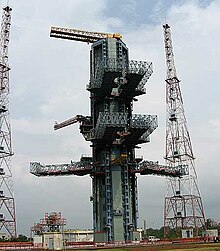Satish Dhawan Space Centre Second Launch Pad
 | |||||||||||||
 | |||||||||||||
| Launch site | Satish Dhawan Space Centre | ||||||||||||
|---|---|---|---|---|---|---|---|---|---|---|---|---|---|
| Location | 13°43′12″N 80°13′49″E / 13.7199°N 80.2304°E | ||||||||||||
| Short name | SLP | ||||||||||||
| Operator | |||||||||||||
| |||||||||||||
The Second Launch Pad of the Satish Dhawan Space Centre is a rocket launch site in Sriharikota, India. It is the second of two launch pads at the centre. The Second Launch Pad or SLP was designed, supplied, erected & commissioned by MECON Limited, a Government of Indian Enterprise, located at Ranchi (Jharkhand, India) during the period March 1999 to December 2003.[1] It cost about ₹400 crore (equivalent to ₹14 billion or US$170 million in 2023) at that time.[2] The second launch pad with associated facilities was built in 2005. However it became operational only on 5 May 2005 with the launching of PSLV-C6. MECON's sub-contractors for this project including Inox India, HEC, Tata Growth, Goderej Boyce, Simplex, Nagarjuna Construction, Steelage, etc. The other Launch Pad being the First Launch Pad. It is used by Polar Satellite Launch Vehicles and Geosynchronous Satellite Launch Vehicles, and is intended for use with future Indian rockets including the Geosynchronous Satellite Launch Vehicle Mk.III[3]
Launches
The first launch from the pad occurred on 5 May 2005, and was of a Polar Satellite Launch Vehicle carrying the CARTOSAT-1 and HAMSAT satellites.[4] As of 2016, 9 PSLVs (all successful) and 6 GSLVs (2 success, 1 partial success & 3 failures) have been launched from the complex. India's 1st Moon Mission, Chandrayan-I was launched from this launch pad on 22 October 2008. The most recent launch was of a PSLV-XL C32 on 10 March 2016.[5]
Facilities
"As per the "Integrate, Transfer and Launch (ITL)" concept, based on which the launch pad and the associated facilities are designed, the entire vehicle is assembled and checked-out on a mobile pedestal in the Vehicle Assembly Building (VAB) and then moved in vertical position to the launch pad on a roll track."[6]
"Other facilities include, Solid Stage Assembly Building (SSAB) connected to the Vehicle Assembly Building (VAB) by a rail track, Technical Complex-2 (TC2), Spacecraft Preparation Facility, Range Instrumentation facilities comprising tracking, telemetry and tele-command systems."[6]
A new assembly building (SVAB - Second Vehicle Assembly Building) being constructed with a budgetary grant of ₹630 crore (US$79 million) is nearing completion and is expected to be ready by mid 2018.This upgrade is expected to increase the launch capacity of second launch pad complex to 11 launches per year.[7]
References
- ^ "Archived copy" (PDF). Archived from the original (PDF) on 20 December 2013. Retrieved 3 September 2013.
{{cite web}}: Unknown parameter|deadurl=ignored (|url-status=suggested) (help)CS1 maint: archived copy as title (link) - ^ http://www.telegraphindia.com/1081023/jsp/jharkhand/story_10006297.jsp
- ^ "Launch Facility". Indian Space Research Organisation. Archived from the original on 17 April 2010. Retrieved 12 April 2010.
{{cite web}}: Unknown parameter|deadurl=ignored (|url-status=suggested) (help) - ^ Wade, Mark. "Sriharikota SLP". Encyclopedia Astronautica. Retrieved 12 April 2010.
- ^ ISRO-developed computer helped PSLV-C17 put satellite in orbit
- ^ a b Public domain text sourced from the link - ISRO Launch Facilities Archived 17 April 2010 at the Wayback Machine
- ^ "PIF Project". Prajasakti.

